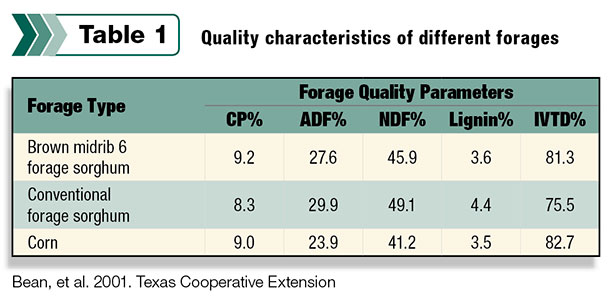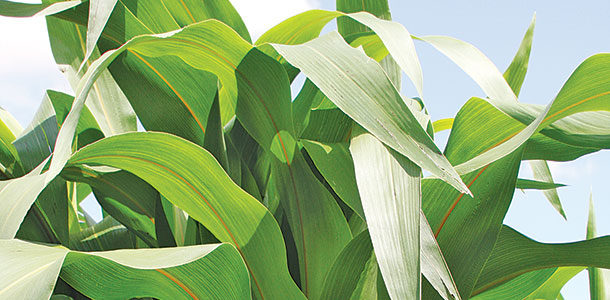Compared to corn silage, forage sorghum is more economical with fewer inputs, has water requirements that are up to 50 percent lower, and some varieties can provide greater or equal nutritive value. These benefits make forage sorghum an attractive option to cow-calf operators, dairies and feedlots.
The management practices required for successfully producing forage sorghum silage are generally similar to those used in growing corn silage: Select the right hybrid, harvest at the correct time, pack properly, and seal it well to avoid contaminants and spoilage.
There are differences as well, but the following steps and considerations should help growers make the most of their sorghum silage.
Select the right hybrid
When searching for the hybrid best suited for your operation, it’s important to select for yield and feed nutrient composition. Some hybrids may produce an abundance of biomass, but do they have the nutritional properties to be an effective source of feed?
Striking the right balance between high tonnage and nutritive value will provide the best results.
Evaluation of forage sorghum hybrids for silage should include varieties with the BMR trait. Forage sorghum silage with the BMR-6 trait has similar nutritive value to corn silage (Table 1; in vitro true digestibility with crude protein percentage), according to a 2001 Texas cooperative extension study.
 According to the study, BMR-6 sorghum produces a higher percentage of digestibility and increased palatability (see neutral detergent fiber percentages), supporting more cattle weight gain and increased milk production than conventional sorghum.
According to the study, BMR-6 sorghum produces a higher percentage of digestibility and increased palatability (see neutral detergent fiber percentages), supporting more cattle weight gain and increased milk production than conventional sorghum.
It’s important to note that not all forage sorghums with the BMR trait are equally effective. According to Johnathon Holman, an agronomist with Kansas State University Extension, “Some BMRs just don’t live up to what other BMRs can.
Just because it is a BMR does not make it necessarily a good variety. Producers need to look at university performance test data and select a variety with good feed quality and yield potential.”
One potential drawback to using a BMR-type forage sorghum is the reduced rigidity of the stalks. The lower lignin levels can cause lodging in some varieties; however, there is a solution.
Hybrids with a combination of BMR genetics and the true brachytic dwarf trait have proven to provide excellent nutritional performance and superior standability.
The reduced internode length of brachytic forage sorghum allows for a shorter (about 6 feet tall), more compact plant. The true brachytic BMR forage sorghum hybrids are proven to produce comparable tonnage to taller hybrids with little to no lodging.
Harvest at the correct time
As the old saying goes, timing is everything, and that’s especially true when it comes to optimum harvest of sorghum silage. The standard recommendation is to harvest at the soft-dough stage.
This is most important for varieties with grain because the sorghum kernels will become increasingly hard and less digestible as the plant matures. If allowed to reach the hard-dough stage, the sorghum grain will likely pass right through the cow.
A good way to handle harvest timing of forage sorghum with grain is to begin cutting when 80 percent or more heading has occurred and 50 percent of the grain reaches the soft-dough stage.
It may be tempting to delay harvest while waiting for whole-plant moisture levels to drop, but that is usually a mistake. Any advantage gained by lower moisture content will be offset by less digestible grain.
In fact, it’s generally a better idea to harvest your sorghum silage a little early rather than a little late. Desirable forage sorghum moisture content usually falls within a range of 63 to 68 percent.
Chop length recommendations vary depending upon the characteristics of the variety or hybrid planted. A half-inch chop is typical for standard forage sorghum varieties while a 1-inch to 1¼-inch chop length is recommended for BMR hybrids to achieve the proper rate of passage for cattle. The longer chop length allows cows to make proper use of the higher nutritive values of BMR forage within the rumen.
Growers may want to consider swathing sorghum, as the plant is frequently too wet when the grain is ideal for ensiling. If planning to swath for silage, it is recommended to monitor moisture in the swath and schedule chopping and hauling accordingly for desired dry matter.
The closer growers can get dry matter levels to the ideal (32 to 36 percent), the more reduction in the amount of leachate (liquid silage runoff) produced.
It’s important to remember that even the greatest forages will not perform well if they are not harvested at the correct timing. Maintaining proper harvest timing will provide higher forage quality.
Pack properly and seal it well
Silage needs to be packed well to allow proper fermentation, protect quality and minimize shrink. Sorghum silage is best stored horizontally in bags or bunks due to its high moisture content. Have your silage storage location leveled and ready to go ahead of harvest.
Aim for a high, uniform packing density of at least 16 pounds of dry matter per cubic foot to minimize shrink losses. Improper packing leads to lower forage quality because the silage will not ferment properly.
Layers packed as thin as possible (no more than 6 inches) work well. Use a 1-to-3 or 1-to-4 slope for piles, and all surfaces should be smooth so that water runs off easily.
A good seal is an important step in the silage process. Bunkers should be covered immediately once filling has been completed to reduce the threat of crop deterioration.
Repair any holes that appear in covers or bags as quickly as possible to minimize spoilage. Keeping excess air from entering the bunker will result in a better fermentation and subsequently higher-quality forage.
A research-proven inoculant is recommended for forage preservation. These additives can reduce butyric acid production, minimize fermentation time, reduce seepage and produce higher-quality silage with less dry matter loss. Inoculant application at the forage chopper is recommended if possible.
Stick to the plan
The silage process can seem complex at times, but it’s important to make sure each step is followed accordingly. Neglecting any portion of the plan can lead to a breakdown in the ensiling process.
Each piece of the plan is essential to ensuring the nutrient value and quality of the silage. Stick to the plan by selecting the right hybrids, harvesting at the correct time, packing properly and maintaining a good seal for successful sorghum silage production. FG
PHOTO: The silage process can seem complex at times, but it’s important to make sure each step is followed accordingly. Photo courtesy of Travis Kidd.

-
Travis Kidd
- Technical Development Manager
- Advanta and Alta Seeds
- Email Travis Kidd











